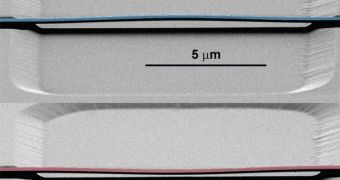A collaboration of researchers at the Yale University announces the development of a new mechanical switch. The device consists of a very small silicon bridge, which can be flipped from one stable configuration through another by light generated from a small laser device.
The research group, led by experts Mahmood Bagheri and Hong Tang, says that the new technology could find a variety of applications in the field of optomechanics, a new area of science that combines the fields of nanotechnology and optics in a single approach to new devices and technologies.
What is most remarkable about the new system is the fact that it operates stably at room temperature, and also that it does not require any power sources to operate, other than the energy used for the laser.
University of Vienna physicist Markus Aspelmeyer, who was not a part of the research, believes that the new study also provides some raw material for scientists working in related fields of research to expand upon.
“This a new paradigm. People are going to take a good look at this and use it in other schemes,” the expert comments. Yale electrical engineers say that the silicon bridge is only 500 nanometers wide by 10 micrometers long. It has as thickness of about 110 nanometers, ScienceNow reports.
According to the team, the bridge lies suspended about 250 nanometers above a glass chip. The secret to the new system is to control the way the bridge moves in a precise manner. Light has been used for such applications for several years, but the level of control thus far possible left a lot to be desired.
“It's very elegant work. It's the first time that [such a system] has been demonstrated in a fairly achievable way. It's definitely feasible,” Cornell University optical physicist Michal Lipson explains.
She explains that the two configurations the silicon bridge is capable of could be of great use for constructing optical computer memory devices. Such electronics would store information in the position of the bridges themselves.
Aspelmeyer adds that the new optomechanic system can be used to control light and its motions in more complex ways than previously though possible. The investigators adds that the secret to making the most of this technology is combining it with other approaches of controlling light.
These include the development of metamaterials, which are materials that cannot be found in nature. They are designed and built from scratch in order to fulfill certain functions, which usually relate to influencing the trajectory of photons in a light beam and similar applications.

 14 DAY TRIAL //
14 DAY TRIAL //